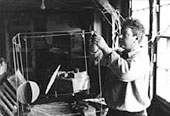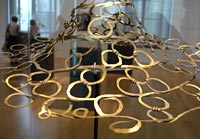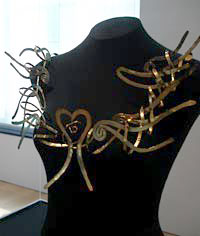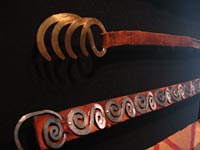Discovering Alexander Calder's Wearable Sculpture Jewelry
Portrait of an Artist: Calder's Early Works
Born into a family of artists in 1898 in Lawnton, Pennsylvania, Calder and his older sister, Margaret Calder Hayes, were encouraged to be creative from an early age. His first sculpture, at age four, was a clay elephant. From 1906, he’d have a studio in each house where he’d create various objects that included his 1909 Christmas gifts to his parents – a three-dimensional dog and rocking duck created from brass sheeting. When he received his first set of tools he used scraps of copper wire that he found in the street to make beads and jewelry for his sister’s dolls.
 Calder in his Roxbury icehouse studio at work on Project for Mechanical Ballet (A14999) for Harrison Kerr, 1934
Calder in his Roxbury icehouse studio at work on Project for Mechanical Ballet (A14999) for Harrison Kerr, 1934Photograph courtesy of the Calder Foundation
Although he initially trained as a mechanical engineer, but worked as an insurance salesman, rototiller salesman and engineer, but couldn’t find his niche. Revisiting his love of art, he began sketching for Ringling Brothers and Barnum and Bailey Circus. Soon after, his first wire and wood figures were born and later known as the Cirque Calder. His drawings were shown at his first exhibition in 1926 in The Artist Gallery, in New York, and he began designing wire sculptures based on those drawings. His animals were constructed of iron wire and corks, which were eventually turned into mechanical toys, much to the delight of children of all ages.
He moved to Paris, and gave improvised shows with his “Cirque Calder”, which were popular with European avant garde artist like Joan Miro, Marcel Duchamp and others. He spent the 1920’s and 30’s traveling between the United States and Europe, which is where he met his wife, Louisa James, on a voyage crossing. They resided in Roxbury, Connecticut and raised a family. But, his love of the circus became the foundation for his work for the next 50 years. He began creating purely abstract art and designed a geometric, colorful shape moved by cranks and pulleys. His work was large—40-feet, but light and balanced with color. His smaller mobiles were the ‘it’ thing to have in the 1950’s. But his jewelry is what sets him apart.
The late Alexander Calder (1898-1976), an internationally known sculptor and artist, became popular throughout the world for his moving sculptures combining his love of art and engineering. Today, Calder is most remembered for inventing the mobile in the 1930s, incorporating the kinetic abstract sculpture of metal pieces, wires and rods balanced to sway with wind currents.
Yet, another side of Calder existed. His most memorable pieces of work shined through in his experimental line of brass, copper and metal jewelry, combining his love of sculpture, mobiles, and whimsy.
 Alexander Calder's brass jewelry, on view at the Philadelphia Museum of Art
Alexander Calder's brass jewelry, on view at the Philadelphia Museum of Art Photograph by Paul David
And now in honor of the 110th anniversary of his birth, a traveling exhibition that began at the Philadelphia Museum of Art showcases Calder’s jewelry, giving viewers a deeper understanding to the collective presence of his art. With approximately 115 pieces on view, Calder Jewelry shows this artist’s vividly imaginative approach to form, showcasing the versatility of copper and brass.
“This is an eye opening show for people familiar with his work because they know he’s the inventor of the mobile and large scale sculptures but many are not aware that he created jewelry on the side, concurrently with the rest of his work,” says Elisabeth Flynn, Media Relations, Philadelphia Museum of Art. “He had sold individual pieces through galleries, trunk shows, and home collectors, and had been approached about mass production, but he wasn’t interested. He wanted each piece to be original and handmade.”
Not noticeable at first glance, at closer inspection viewers can see the engineer-minded side of Calder as he seems to do the impossible without the use of welding. Necklaces, bracelets, brooches, earrings and tiaras transcend the traditional mechanicals of jewelry, seeming to defy gravity and basic physics.
Some of the works are seemingly one piece, but really many pieces linked together, like Calder’s slim silver necklace. At first look, it appears to have a string of circles hanging from the neck to the waist, made from wire similar to a chain mail medieval vest, but the circles are not one piece—they’re all circles, reinvented.
 Wearable sculpture necklace by Calder
Wearable sculpture necklace by Calder
Photograph by Paul David
“He’s wasn’t a jeweler, so he didn’t weld. He worked on an anvil and bench, but didn’t solder anything,” says Philadelphia Museum of Art’s Elisabeth Agro, the Organizing Curator for the Calder Installation. “He actually stabled things by hammering wire then flattening it and broadening it before creating different shapes likes spirals or circles. His brass wire was a heavy gauge that many brass pieces are created from. It’s not a beautiful wire, but what he does with it is fabulous.”
Calder’s approach to jewelry is unique in style and construction, each piece formed using basic fabrication techniques that are reminiscent of ancient jewelry practices.
“He definitely saw African metal work, must have been in the 30’s with France and the colonies – and he must have been looking at the male tribal corsets worn by the Dinka tribe,” says Agro, adding that Calder was also inspired by the Celts, Egyptians, and Native American culture.
According to Flynn, Calder didn’t think his jewelry was less important or an art form, but in his workshop he’d have several stations going at one time so he’d work with a large sculpture, then stop to design and create jewelry, and would go back to work on the sculpture.
Focusing on how the necklace would be successful as a piece of jewelry and a wearable sculpture, Agro says that many of Calder’s necklaces are an extension of his work on a smaller scale and he made them spontaneously.
“This work is the embodiment of all his sculptural work—both the mobiles and stabiles—but his jewelry is sculpture for the body,” says Agro. “He produced approximately 1800 pieces of jewelry over his lifetime, and most are owned by the Calder Foundation in New York, but some are in private hands and a few in public collections.
 Detail of Calder's cold-soldered jewelry
Detail of Calder's cold-soldered jewelryPhotograph by Paul David
His most famous jewelry piece is probably the hammered brass Jealous Husband necklace, worn by Angelica Houston, in 1976, on the cover illustrated for the New York Times Magazine. It’s a piece that sits on the shoulders that has cantilevers, talons or daggers sticking up with small mini-mobiles that hang from your shoulder. The purpose of this necklace was that no one would hug you or come near you – the wearer is protecting themselves from people.”
Calder wanted the wearer and jewelry to become conjoined, so the act of wearing the jewelry initiated a performance, maybe by fantasy or the activation of a necklace or earrings by the slightest move of the wearer.
“Most of his pieces are abstract, sculptured works, but it’s definitely not about bling,” says Agro. “He’s thinking of sculpture, and the person wearing his jewelry becomes a sculpture just by wearing his work.”
Resources:
Also in this Issue:
- Discovering Alexander Calder's Wearable Sculpture Jewelry
- Thing 1, Thing 2, Bronzed Anew: The Dr. Seuss National Memorial Sculpture Garden
- Patience Required: Chasing Copper and Silver
- Rodin Retrospective at the Frist
